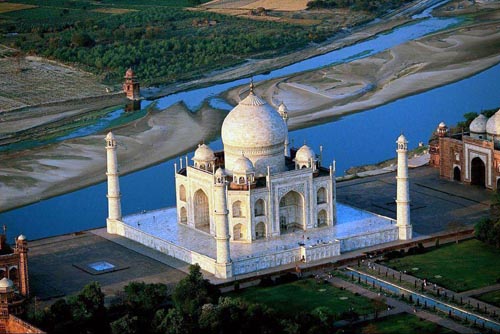Taj Mahal Agra

Information on Taj Mahal (Agra, Uttar Pradesh) - History & Architecture
India is known to be a country that is rich in heritage and historically significant. The Mughal period, their architecture and monuments call for a compulsory mention when exploring the historical value of India. Historical monuments are considered to be an integral component of the country among which the Taj Mahal holds a place of intense connotation owing to its magnificent form of architecture. Taj Mahal is usually identified to be amongst the most admired form of Muslim art thus, making it a masterpiece with regard to global heritage. Therefore, the mentioned features contributed towards including it among the Seven Wonders of the World.
Taj Mahal Agra Architecture
Taj Mahal is considered to be the epitome of Mughal architecture as it marks the confluence of Islamic, Turkish, Indian and Persian styles of architecture. It was declared to be a World Heritage Site by United Nations Educational, Scientific and Cultural Organization (UNESCO) in the year 1983. The monument is actually an arched mausoleum that is made of white marbles along with an incorporated complex of formations and is located in Agra, Uttar Pradesh. Agra is situated near the Yamuna River and is considered to be quite a populated city of the state. Presence of the splendid monument, namely Taj Mahal makes Agra quite a popular city. Agra city is learnt to have been mentioned in the eminent epic Mahabharat and in the year 1506 during the reign of Sultan Sikandar Lodi, Agra was made the capital from Delhi. Presently, the city claims the presence of three World Heritages by UNESCO and they are Agra Fort, Fatehpur Sikri and Taj Mahal.
Taj Mahal stands for "crown of palaces" and it truly lives up to its name owing to its supremacy as one of the most iconic monuments. The delicate minarets, the elegantly curved arches and domes in white opulent marble have enthralled millions worldwide. The construction of the monument is estimated to have commenced in the beginning of the year 1632 and took around 20 long years for it to complete which was approximately in the year 1653 with a budget of nearly 32 million rupees. It is predicted that over 22, 000 people were engaged in order to construct this extraordinary and splendid building which included painters, embroidery artists and stonecutters along with many others.
A big white dome in the shape of an onion is supposed to be one of the most popular identifiable features of Taj Mahal. The mentioned white dome claims an approximate height of 35 metres which is again encircled with four such similar kinds of smaller domes. The complete height of Taj Mahal is measured to be 171 metres.
Taj Mahal Agra History
The Taj Mahal was erected in the honour of Mumtaz Mahal as her absolute resting place by husband Shah Jahan, the eminent Mughal emperor and the grandson of great Akbar. Mumtaz Mahal was the third wife of Shah Jahan who died in the year 1631 while giving birth to her last and fourteenth child. The mortal remains of her were provisionally buried at Zainabad garden but after a period of six months, the body of Mumtaz Mahal was moved to Agra for the purpose of finally preserving it in the burial chamber of Taj Mahal. The monument stands as the burial chamber of both Shah Jahan and his wife Mumtaz Mahal.
The eternal love for one's wife adds a character to the monument which is worth knowing and therefore, the monument, more than a marvelous piece of art, stands out to be an embodiment of love.
- Andaman Nicobar Monuments
- Andhra Pradesh Monuments
- Assam Monuments
- Bihar Monuments
- Chhattisgarh Monuments
- New Delhi Monuments
- Goa Monuments
- Gujarat Monuments
- Haryana Monuments
- Himachal Pradesh Monuments
- Jammu and Kashmir Monuments
- Karnataka Monuments
- Kerala Monuments
- Madhya Pradesh Monuments
- Maharashtra Monuments
- Odisha Monuments
- Punjab Monuments
- Rajasthan Monuments
- Tamil Nadu Monuments
- Telangana Monuments
- Uttar Pradesh Monuments
- West Bengal Monuments